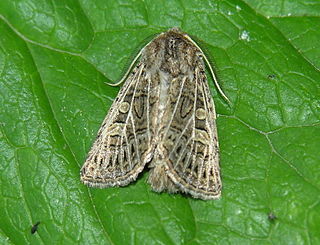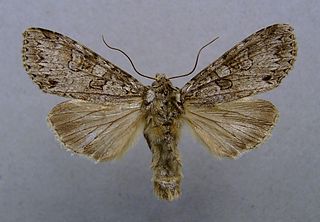
The pine beauty is a moth of the family Noctuidae. It is a common species of pine woods in Europe. The distribution area extends from Portugal to western Siberia, the Caucasus and Asia Minor. In the north it extends to the Arctic Circle, in the south it is found in Ceuta in Northern Africa in and southern Italy.

The setaceous Hebrew character is a moth of the family Noctuidae. The species was first described by Carl Linnaeus in his 1758 10th edition of Systema Naturae. It is found in the Palearctic realm. It is a common species throughout Europe and North Asia and Central Asia, South Asia, China, Japan and Korea. It is also found in North America, from coast to coast across Canada and the northern United States to western Alaska. It occurs in the Rocky Mountains from Montana to southern Arizona and New Mexico. In the east, it ranges from Maine to North Carolina. It has recently been recorded in Tennessee.

The six-striped rustic is a moth of the family Noctuidae. It is distributed throughout Europe apart from the far south east.

The bright-line brown-eye is a moth of the family Noctuidae. The species was first described by Carl Linnaeus in his 1758 10th edition of Systema Naturae. It is a common species throughout Europe, but is also found in North Africa, temperate North Asia and Central Asia, Asia Minor, Syria, and Turkestan, northern India, China, Korea and Japan.

The lychnis is a moth of the family Noctuidae. It is found in northern and western Europe and Turkey. It has an Atlantic-Mediterranean distribution. In the East Palearctic it is replaced by Hadena capsincola.

Calamia tridens, the Burren Green, is a moth of the family Noctuidae.

Ipimorpha subtusa, the olive, is a moth of the family Noctuidae. It is found in the Palearctic realm.

Colocasia coryli is a moth of the family Noctuidae. It is found in Europe and Asia. In the north of its range, the distribution area includes northern Scandinavia, while in the south the moth is limited to montane areas of western and northern Spain, Sicily, Greece, Romania and Asia minor. To the east, the range extends across the Palearctic to Lake Baikal. In the Alps it is found at elevations up to 1600 m.

Hada plebeja, the shears, is a moth of the family Noctuidae. It is found in Europe and across the Palearctic to Asia Minor, Armenia, Turkestan, Central Asia, Mongolia, Siberia, as well as Kashmir.

Plusia festucae is a species of moth of the family Noctuidae. It is found throughout the Palearctic realm from Ireland to Japan.

Sideridis rivularis, the campion, is a species of moth of the family Noctuidae. It is found in from the northern part of the Iberian Peninsula, through the whole of Europe. To the east, it is found in Central Asia and Siberia, up to Manchuria. To the south, it is found in the Mediterranean Sea region and parts of Asia Minor. In the Alps, it is found at up to 1,600 metres above sea level.

Tholera decimalis, the feathered Gothic, is a species of moth of the family Noctuidae. It is found in Europe and Scandinavia then through the Palearctic to Asia minor, western Central Asia, southern Siberia and in North Africa.

Polychrysia moneta, the golden plusia, is a moth of the family Noctuidae. It is found in the Palearctic realm.

Sideridis reticulata, commonly known as the bordered Gothic, is a moth of the family Noctuidae. It is found in the Palearctic realm, from the Iberian Peninsula throughout Europe and the temperate regions of Central Asia and the Russian Far East. In the north it occurs in Fennoscandia south of the Arctic Circle. In the south it ranges to the Mediterranean. It rises to over 2000 metres above sea level in the Alps.

Autographa jota, commonly known as plain golden Y, is a moth of the family Noctuidae. The nominate form is found in Europe. while the subspecies Autographa jota anatolica is found in the southern Balkans, south-western Asia, Turkey, the Caucasus, and north-western Iran.

Hadena perplexa, also known as the tawny shears or pod lover, is a species of moth of the family Noctuidae found in Asia, Europe and North Africa. It was first described, in 1775, by the Austrian lepidopterists Michael Denis and Ignaz Schiffermüller from a type specimen found in the Vienna District of Austria.

Xestia castanea, the grey rustic or neglected, is a moth of the family Noctuidae. It is found from central Europe to Morocco, Turkey, Lebanon, Israel, Jordan and Syria.

Hadena caesia, also called the grey, is a species of moth of the family Noctuidae. It has a scattered distribution all over Europe.

Polia nebulosa, the grey arches, is a moth of the family Noctuidae. The species was first described by Johann Siegfried Hufnagel in 1766. It is found in temperate Europe and Asia up to eastern Asia and Japan. It is not present in northernmost Fennoscandia and the southern parts of the Iberian Peninsula, Italy and Greece. In the Alps it is found at heights up to 1,600 meters.

Photedes captiuncula, the least minor, is a moth of the family Noctuidae. It is found throughout Europe, in Turkey, Armenia, Russia and much of temperate Asia.




















